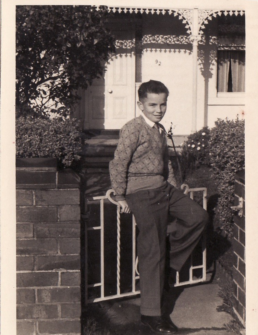These life stories may contain descriptions of childhood trauma and abuse, as well as images, voices and names of people now deceased. If you need help, you can find contact details for some relevant support services on our support page.
Australian builder, Bill McLeary (b. 1943), was in a children’s home and kinship care as a child.
William McLeary was born in Sydney, the youngest in a family of seven children living in Balmain. When he was three, Bill’s mother died of asthma. Eighteen year old Netty, Bill’s oldest sister, took Bill to the Burnside Homes for Children at North Parramatta and left him “inside with two ladies” (McLeary).
Suddenly the front door closed and Netty was gone. I remember that door: it was massive. Netty had gone and I was alone! I screamed and cried and shouted for I don’t know how long (McLeary).
Bill began at Burnside in Troup House, later moving to Blackwood, the cottage home for “older boys”. Life was regimented, with the children having to line up to go to the dining room and bathroom. In the bathroom there was no privacy, which was a source of embarrassment and humiliation for Bill, as was having his knees scrubbed by “matron”.
Punishment was harsh. Bill was “battered and bruised” with a strap when he had a game of golf on a lawn area. If Bill did not want to eat his food, he would be made to stay at the table until he finished, even if that meant eating his vomit.
Bill’s father rarely visited the child at Burnside, although his sister Netty was a regular. Bill’s sisters, Helen and Mary, were in Burnside too, but Bill did not see much of them.
Then, in 1954, Mary and Bill were asked if they would like to live with their father and his partner, Eva. Anxious to get out of Burnside, they agreed. At first, Bill’s father and Eva “stayed off the grog”, but soon “Dad got on the cheap plonk again.”
I still remember the smell of cheap, stale wine on his breath. It was revolting, sickening. He was a big hard man and I remember him beating Eva up when he came home drunk. It was all terribly, terribly frightening for me and embarrassing too (McLeary).
Soon the authorities found out what was happening at home, and it was back to Burnside, for Bill at least. By then Mary was seventeen and she went to live with their sister, Helen, who was married and in Melbourne.
After a stint back in Burnside, Bill again returned to live with his father, but he ran away so often to his sister Netty’s house that she became his legal guardian.
Bill took up paid work at thirteen, becoming a paper boy for a local Balmain newsagent. He was also captain of the rugby league team at Charleston Public School and began playing rugby for the state team.
At fifteen, Bill went to live in New Zealand with an older brother, Johnny. There, he joined the Army Reserves and a local rugby team.
In 1964, Bill moved to New Guinea where he worked on building sites for about seven years. While in New Guinea, Bill met his first wife, Kay, and the couple saved up for a home in Adelaide, South Australia where Bill set up in business as a builder.
After Bill suffered three significant losses – his second son Ward in an accident, his business, and his marriage—he returned to Sydney where he eventually met his second wife, Avis. The couple built a home in Avoca Beach where Bill worked for the local council until he retired.
Bill had long been aware of social anxiety that inhibited some of his work opportunities. The anxiety began at Burnside, but would not have been helped by his father who, “in a drunken rage, had thrown Eva over the balcony and killed her.”
Despite his difficulties, Bill has contributed to the Australian community through playing sport for his school, state and community, through his paid work as a builder, by raising three children, and by speaking out about his experiences in Burnside.
When the government had an enquiry into children raised in care, I scoffed at the word ‘care’. I made a submission and was called to be questioned…I was terribly nervous and at the same time it felt good to stand up and tell my story out loud (McLeary).
References:
McLeary, Bill. Burnished: Burnside Life Stories Compiled by Kate Shayler. Hazelbrook, NSW: MoshPit Publishing, 2011.
“Burnside Presbyterian Homes for Children (1955 – 1978).” Find & Connect, 2021. https://www.findandconnect.gov.au/guide/nsw/NE00252
Image available supplied.
